Southern Channel Islands Information for Catalina, San Clemente, Santa Barbara, and San Nicolas Islands
The Channel Islands are very diverse and large. Because of this, we have made two separate pages covering the islands. This one has the four Southern Channel Islands and the other page has the four Northern Islands. We have not only covered some of the history and details of each island but we have also listed many of the dive sites and info about scuba diving the islands. Some of the dive sites you will find on maps and others you won’t. Over the years, Ken the owner of Channel Islands Dive Adventures has dived all these sites.
We hope you enjoy all the information listed here and come back to read a little each time. There is just way too much to check out at one time.
Catalina
San Clemente
Santa Barbara
San Nicolas
Santa Catalina Island
 Catalina Island is 21 miles long and 8 miles wide at the widest point. Its perimeter of 54 miles encompasses approximately 47,884 acres or about 76 square miles. The highest point on the island is Mt. Orizaba at 2,097 feet. It is 26 miles from Avalon to San Pedro and 21 miles from Arrow Point on Catalina to Point Vicente on the mainland. Catalina is the third
Catalina Island is 21 miles long and 8 miles wide at the widest point. Its perimeter of 54 miles encompasses approximately 47,884 acres or about 76 square miles. The highest point on the island is Mt. Orizaba at 2,097 feet. It is 26 miles from Avalon to San Pedro and 21 miles from Arrow Point on Catalina to Point Vicente on the mainland. Catalina is the third 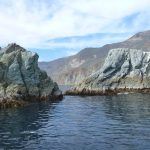 largest of the Channel Island group.
largest of the Channel Island group.
Catalina Island has a few small communities, such as Two Harbors on the Isthmus, but 2.6 square miles Avalon is the only incorporated city. Catalina has buffalo, bald eagles, and mountain goats along its steep canyons and rolling hills. There are lots of fun things to do while on Catalina. Catalina Island is technically in 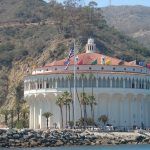 Los Angeles County and is a popular day trip and vacation destination for locals and tourists.
Los Angeles County and is a popular day trip and vacation destination for locals and tourists.
Catalina is a world unto itself and an excellent place to get away from the hustle and bustle of the rest of Southern California. Most of the island is owned by the Catalina Conservancy which is in charge of protecting its environment.
Best Time to Dive
Water temps average in the low to mid 60’s, with lows in the high 50s in winter and topping out in the low 70s in the summer. Visibility is generally always very good with an average of 30’-50’ and at times it can reach close to 60’-80’plus.
Diving Santa Catalina Island
Scuba diving at Santa Catalina Island is a favorite destination for divers of all skill levels. For shore diving, the main dive site is Casino Point at the Marine Park, right next to the Casino building in Avalon.
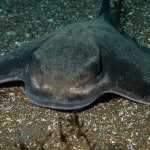 The “front side” is the leeward (sheltered) side of the island and with such good water clarity, little current and calm waters, photography, sightseeing, and dive training are very popular activities around the Island. The backside of Catalina is exposed to the weather and therefore is not the most accessible but when it is it offers some excellent diving opportunities.
The “front side” is the leeward (sheltered) side of the island and with such good water clarity, little current and calm waters, photography, sightseeing, and dive training are very popular activities around the Island. The backside of Catalina is exposed to the weather and therefore is not the most accessible but when it is it offers some excellent diving opportunities.
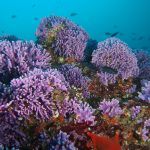 One well-known dive site on the backside is Farnsworth Bank, about two miles off the center part of the island. Farnsworth Bank is a deep offshore pinnacle mainly known for its abundance of purple hydrocoral and because of its exposed location, it can be very hard to get to.
One well-known dive site on the backside is Farnsworth Bank, about two miles off the center part of the island. Farnsworth Bank is a deep offshore pinnacle mainly known for its abundance of purple hydrocoral and because of its exposed location, it can be very hard to get to.
With large kelp beds, a variety of life, Black Sea bass, bat rays, fish, seals, invertebrate life, rocky reefs, pinnacles, and walls, it offers something for everyone.
*Just an FYI-In April 2003, sargassum grass was found at three sites along the front side of Catalina. As time went by it invaded almost all the dive sites around 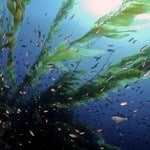 Catalina plus it spread to some of the other islands but not like it did at Catalina. At Catalina, it seemed to take over everything, and diving many of the front side dive sites just were not the same.
Catalina plus it spread to some of the other islands but not like it did at Catalina. At Catalina, it seemed to take over everything, and diving many of the front side dive sites just were not the same.
Now in 2020, it seems some of the kelp is coming back to dive sites along the front side of Catalina and things are starting to get back to a somewhat normal state. The west end and backside have very little of the sargassum grass and healthy kelp so these sites are probably the best to visit if you plan to dive Catalina Island.
Because of Catalina’s size, we will cover it in two parts-Northside (frontside) from the west end to the east end and the Southside (backside) from the east end to the west end.
Listed are a few of the great dive sites around Santa Catalina Island:
Northside (frontside) from the west end to the east end:
- Black Rock-This is actually Black Point and the inside eastern area is large rocks with lots of kelp, sealions, sheepshead, lobster, harbor seals and it slopes gradually to a sand bottom around 60’. The point that is Black Rock is very rocky with lots of large crevices, ledges, walls, and gorgonians. It drops abruptly to about 100’. This is a great dive for hunters or photographers with depths between 15’-100’.
- Parsons Landing-Large rocks the size of cars or bigger with large crevices creating small cavern-like areas. Lots of kelp, gorgonians, sheepshead, calico, kelp bass, and lobsters. Sandy bottom between the large rocks making this another excellent dive. Depths are between 30’-50’.
- Arrow Point-The point here drops down sharply with lots of rocky structures, ledges, and crevices. There can be a strong current at the point so be careful when in that area. The usual Ca
- Eagle reef-Large reef structure that is more like a sea mound. There are small walls, ledges, crevices, and rocks sloping down to a sandy bottom. Lots of kelp, gorgonians, sheepshead, calico, kelp bass, lobsters, sea lions, and sometimes a good place to see giant black sea bass. There are actually two areas to this site with a small valley in between them. Good invertebrate life on the reef and good for hunting and photography. Depths are between 20’-100’ plus.
- Ship Rock-This site is about 2 miles offshore from Isthmus Cove and a short way out from Bird Rock. You cannot miss it as it is exposed and looks like a very small Matterhorn like at Disneyland. The south and east side are shallow and extend a distance off the main rock with large rocks, lots of kelp, lobster, moray eels, sheepshead, calico, kelp bass, and other rockfish. You could even see a bat ray or sea lion cruise by you. The north side drops steeply with small walls, large crevices, and ledges. It gets deep fast and the sargassum grass stops at a depth of about 60’-70’. You can see schooling fish out along the slope with big gorgonians and lots of invertebrates. Great spot for the photographer. Depths are between 20’-130’.
- Bird Rock-This is easy to find by all the white snow on it. It is a large rounded exposed rock out from Isthmus Cove that has reef all around it and is part of the Bird Rock State Marine Conservation Area (SMCA). Depths On the north side it is a wall with large rocks, big crevices, and some ledges. It drops down to a rocky/sandy bottom with lots of kelp, gorgonians, rockfish, kelp bass, and lobsters. The south side is shallow with a rocky reef and gradually slopes to deeper water. Depths are between 15’-80’.
- Isthmus Reef-This is another good site that has both nice shallow and deep areas. It has steep walls with lots of ledges to the west, north, and east sides, and the south side, as well as the top, is shallow. Lots of rocky structure here with crevices, healthy kelp, kelp bass, rockfish, sheepshead, lobsters, sea lions, harbor seals, and more. Depths are between 15’-110’ plus.
- Blue Caverns-This site is part of the Blue Cavern State Marine Conservation Area (SMCA) and no anchoring of a boat is allowed. When diving this area you must either anchor outside the area or do a drift dive which is really the BEST way to dive it. There is a rocky reef with kelp along the top, close to the island and then it drops off fast to mini-walls, caves, large crevices, and ledge with LOTS of gorgonians hanging off the wall. The main point of interest here is the large wall and cavern that is close to the middle of the preserve that drops from 30’ to about 75’. You can find large calico, kelp bass, rockfish, sheepshead, bat rays, and sometimes giant black sea bass. Depths are between 20’-100’.
- Rock Quarry-This site gets its name from being next to the rock quarry at Catalina Island that provided much of the rock for the break walls around San Pedro and LA Harbor. It has large break wall type rocks running the length of it that slope steeply to a sandy bottom. It has thick kelp, kelp bass, sheepshead, sea lions but the main point of interest here is the scythe butterflyfish you can find here typically at a depth of about 25’. Depths are between 20’-120’.
- Italian Gardens-Rocky reef in the shallow area and some smaller rock outcroppings with lots of sand as it slopes away sharply to the bottom. Kelp, some fish such as calico, sheepshead, and kelp bass but better spots for giant black sea bass viewing. At times there have been up to 10 or more giant black sea bass at this site. Depths between 20’-100’.
- Long Point-This area is in a good anchorage so beware of boaters not knowing anything about divers. The protected area is rocks along the island leading gently down to the sandy bottom. As you get further out towards the point the rocky structure gets steeper with large crevices and ledges. Be careful as the current can get strong along the outer edge. Here you can see some schooling fish along with calico, rockfish, moray eels, and maybe halibut in the sand, kelp, and lots of invertebrate life on the rocks. Depths are between 20’-80’.
- Valiant Wreck-The Valiant was built in 1926 as a luxury yacht. In December 1930 a fire broke out on her that burned for three days after which she finally sank. There are a number of stories about her and she has been salvaged much over the years. She now rests under a mooring buoy in Descanso Bay and permission from the Harbormaster must be given before attempting to dive her. She sits upright in the sand with some kelp growing from her. Lots of invertebrate life on her along with sheepshead, kelp bass, some rockfish, and sometimes a giant black sea bass or bat ray will be spotted. Depths are between 75’-100’.
- Casino Park-Here you will find everything for everyone and that is the reason this is a VERY popular site for classes. This site is located on the island next to the large Casino (ballroom) building and has a dive trailer for rentals and air on the premises along with bathrooms and lockers. This site is really a few in one. After walking down the stairs you can go straight out where you will find some small boats sunk in a sandy bottom with some rocks. As you reach the boundary of the park the depths are about 60’. If you go to the west you will find another rocky reef with sand gradually getting to about 40’. Down the stairs and to the east you will find it drop of rather quickly with large rocks and crevices down to depths of about 100’. There are also some other small wrecks in this area to explore. You will find lots of healthy kelp here along with large fish such as calico, sheepshead, rockfish, and usually some giant black sea bass. You can also have sightings of bat rays, moray eels, and octopus plus it is known to be an excellent night dive. Even in the shallows can be some great snorkeling. Depths are between 10’-100’
- Little Farnsworth-This is a pinnacle but more like a large submerged rock with some kelp on it. There are ledges, big crevices, and steep sides all around it leading to a sandy bottom. You can see rockfish, sheepshead, lobster, and lots of gorgonians along with plenty of invertebrate life due to the currents that pass by this site. Depths are between 50’-100’ plus.
Southside (backside) from the east end to the west end:
- Church Rock-Large exposed rock off the east end of the island. Large boulders and rock with crevices creating mini walls and swim through’s. Sandy area on edge of the reef where halibut can sometimes be found. Lots of kelp, large calico, sheepshead, lobster, rockfish, and kelp bass making it good for hunters. Some sighting of bat rays, sea lions, and harbor seals along with much invertebrate life on the rocks. Depths are between 20’-70’.
- Salta Verde Point-Rocky reef with lots of crevices to explore along with kelp and sandy bottom in areas. Plenty of fish life with sheepshead, calico, kelp bass, rockfish, halibut, lobster, and maybe a bat ray or two. Large gorgonians and lots of invertebrate life make this an excellent dive site when weather permits. Depths are between 20’-80’.
- Farnsworth Bank-This site is a famous pinnacle dive a few miles offshore from Catalina. It is a very weather dependent area that can have strong currents with fishing boats that know nothing about divers so be extra careful when diving this site. It is actually a series of large pinnacles that in some places are more like a sea mound. It is all very rocky with jagged rock at the top, valleys, walls, large crevices, and ledges. You have it all here! It is known for the large concentration of purple hydro coral that grows on the rocks, large schools of fish along with lots of kelp, rockfish, kelp bass, large sheepshead, octopus, sea lions, electric torpedo rays, lobster, morays, and more. It also has LOTS of invertebrate life and excellent for the photographer. There is much to dive and see between 50’-90’ with depths exceeding 130’ plus. Farnsworth is also part of the Farnsworth Offshore State Marine Conservation Area (SMCA).
- Pedestal Rock-A pinnacle that is more like a large rock mound with large crevices, ledges, and steep sloping walls leading to a sandy bottom. Lots of kelp, gorgonians, kelp bass, rockfish, lobsters, sheepshead, calico, and more. Lots of invertebrate life on the rocks and tube anemones, halibut, and more in the sand. Some say there is a cave at 90’ ft. and depths are between 20’-100.
- Cape Cortez-There is actually two sides to Cape Cortez and both are good dives and very similar. The area to the west is a little lusher with more rocks and dense kelp and the area to the west seems to be more spread out and not as dense but equally as good. Both have large rocks similar to quarry rocks with lots of crevices, ledges, and small walls. Lots of kelp, rockfish, kelp bass, some octopus, bat rays, sheepshead, sea lions, and lots of gorgonians growing on the rocks. The shallow area has some eelgrass with some large calico and is a fun place to explore and the reef slopes to a sandy bottom. Depths are between 10’-80’.
- Iron Bound Cove-Nice protected cove with lots of kelp and large rocks sloping steeply to the sandy bottom. Sheepshead, calico, rockfish, kelp bass, gorgonians, octopus, bat rays, sea lions, harbor seals, and more. Lots of invertebrate life and great for the photographer. Depths are between 15’-60’.
- Eagles Nest- Eagles Nest is very similar to Iron Bound Cove except that Eagles Nest it is named for the eagles nesting at the top of the cliffs. There is a video cam setup to see them and you can view that
- Wild West-This site has large rocks the size of cars and bigger with large crevices creating small cavern-like areas and some small swim through’s. Lots of kelp, gorgonians, sheepshead, calico, kelp bass, lobsters, bat rays, sea lions, and invertebrates on the rocks. There is a sandy bottom between the large rocks and as you dive further out the rocks get bigger to where there are small walls making this another excellent dive. Depths are between 20’-70’.
San Clemente Island
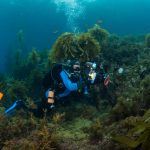 San Clemente Island is the southernmost of the eight California Channel Islands. It lays 55 nautical miles (nm) south of Long Beach and 68 NM west of San Diego and approximately 25 miles south of Santa Catalina. The island is approximately 21 nm long and is 4.5 nm across at its widest point. Since 1934, the island has been owned and operated by various naval commands for testing and training to ensure Navy personnel are ready to respond to national security challenges. These areas
San Clemente Island is the southernmost of the eight California Channel Islands. It lays 55 nautical miles (nm) south of Long Beach and 68 NM west of San Diego and approximately 25 miles south of Santa Catalina. The island is approximately 21 nm long and is 4.5 nm across at its widest point. Since 1934, the island has been owned and operated by various naval commands for testing and training to ensure Navy personnel are ready to respond to national security challenges. These areas 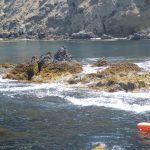 are the cornerstone of the Navy’s tactical training activities in Southern California.
are the cornerstone of the Navy’s tactical training activities in Southern California.
More than a dozen range and operational areas are clustered within a 60-mile radius of the island. The Commander-in-Chief, Naval Forces, Pacific (CINCPACFLT) is the major claimant for the island, and Naval Air Station, North Island (NASNI) is responsible for its administration. Most areas around the island are accessible to the public for commercial and recreational purposes such as diving and sportfishing. 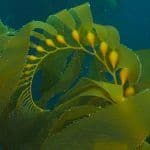
Except in exclusive use or restricted areas, public access is allowed in other areas during periods when they are not being used for military training activities. The only problem with this is there are times the military will decide to do training in a given area and you will not know till that moment so always have a backup plan.
Diving San Clemente Island
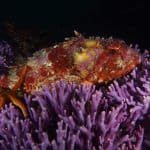 Scuba diving at San Clemente Island can be very rewarding and is good for all level divers attracted by the abundant sea life, including sea lions, lobsters, hydrocoral, kelp forests, and the big bull calicos. The leeward side of San Clemente is home to consistently good water clarity, usually better than that found at Catalina. The typical visibility is 50′ – 80’+ and water temperature is usually warmer like that of Catalina Island.
Scuba diving at San Clemente Island can be very rewarding and is good for all level divers attracted by the abundant sea life, including sea lions, lobsters, hydrocoral, kelp forests, and the big bull calicos. The leeward side of San Clemente is home to consistently good water clarity, usually better than that found at Catalina. The typical visibility is 50′ – 80’+ and water temperature is usually warmer like that of Catalina Island.
San Clemente Island is extremely diverse with its steep walls, large rocky reefs, underwater caverns, large rock 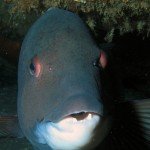 outcroppings, isolated deep-water reef systems, and pinnacles. San Clemente has an abundance of marine life such as large kelp beds, seals, bat rays, big fish, and lots of invertebrates, lobster, purple coral colonies and so much more. There is so much to see and do underwater at San Clemente Island that even after diving there for several days you will still have much more to see on return visits.
outcroppings, isolated deep-water reef systems, and pinnacles. San Clemente has an abundance of marine life such as large kelp beds, seals, bat rays, big fish, and lots of invertebrates, lobster, purple coral colonies and so much more. There is so much to see and do underwater at San Clemente Island that even after diving there for several days you will still have much more to see on return visits.
When the weather conditions are good and you can dive the south windward side of San Clemente Island, the diving becomes limitless. San Clemente Island is perfect for photographers and it is equally as good for the spearfishing person or sightseer.
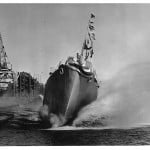 San Clemente is also home to quite a few wrecks with the best being the John C. Butler, a naval destroyer sitting on an 80′ sandy bottom in Northwest harbor. San Clemente Island has many good dive sites and because of its size, we will cover it here in two sections-Northeast side from Northwest harbor to Pyramid Point and the Southeast side from Pyramid Point to Northwest Harbor.
San Clemente is also home to quite a few wrecks with the best being the John C. Butler, a naval destroyer sitting on an 80′ sandy bottom in Northwest harbor. San Clemente Island has many good dive sites and because of its size, we will cover it here in two sections-Northeast side from Northwest harbor to Pyramid Point and the Southeast side from Pyramid Point to Northwest Harbor.
Listed are a few of the great dive sites around San Clemente Island:
Northeast side from Northwest harbor to Pyramid Point:
- Northwest Harbor-Beautiful area that is closed by the military most of the time. Rocky reef with large rocks, eelgrass, lush kelp, sheepshead, calico bass, rockfish, kelp bass, and more. Lots of invertebrate life and great for wide-angle and macro photography. Depths are between 20’-50’.
- John C. Butler-Over the years the John C. Butler is slowly leaving us and today there isn’t much left but it is still an exciting dive on a once valiant fighting ship. She was built in November 1943, served a distinguished life, and eventually decommissioned for the last time in December 1957. In June 1970 she was removed from the Navy Register and sunk in December 1971 after being used for target practice. The John C Butler now lays on a sandy bottom in Northwest harbor at a depth of 100’. Read more about John C. Butler who the ship was named after here. More information.
- Koka-The Koka was built as a Navy tug in February 1919 and stationed in San Diego, CA. In 1937 she ran aground on the east point of Northwest Harbor. Today there isn’t much left and unless you are with someone who knows about here you probably will not know you are upon a wreck. What is left is broken up on the rocks at a depth of 20’-30’. More information.
- LCI Reef-Excellent rocky reef that is more like a large rocky mound with lots of crevices. Lots of kelp, big calicos, sheepshead, rockfish, and lots of invertebrate life. This is in another area that is closed most of the time. Depths are between 30’-50’.
- Octopus Gardens-Excellent dive at a very rocky reef close to shore with large crevices that extend out like octopus tentacles. Healthy kelp, rockfish, kelp bass, sheepshead, bat rays, sea lions, and more. Lots of invertebrate life and great for photography. Depths are between 20’-50’.
- Window Pane-This is an exciting dive relatively close to shore. This is a wall dive with a shallow rocky area at the top. The sheer wall has lots of ledges and crevices that plunge to the depths and it is along the wall where you see the most. Gorgonians, bat rays, schooling fish, moray eels, sometimes giant black sea bass, and sea lions all in very blue clear water. A dive here is like diving in a warm water destination. Depths around 30’-40’ in the shallow area and the wall drops to over 120’.
- Little Flower-This area is in a protected cove This starts out as a nice shallow area with large rocks and sand channels, lots of kelp, eelgrass, occasional leopard shark, bat rays, sea lions, and large calicos. As you get further out you come to a wall similar to the one at Window Pane but not as large and here you will find lots of ledges and crevices with lots to see such as lobsters, moray eels, schooling fish out in the blue, and lots of invertebrate life. Depths are 20’-40’ in the shallow area and the wall drops to around 80’ in the sand.
- Fish Hook-Another site similar to Window Pane and Little Flower. Here there is a small cove in the curved part of what would look like a fish hook, hence the name “Fish Hook”. The shallow area is very rocky with lots of crevices and plenty to see and sometimes you can see leopard sharks here. As you get out of the cove and along the flat long area of the fish hook swimming towards the eye you will find a wall that is much like the others and equally as nice. Depths in the shallow area are between 10’-40’ and the wall drops to over 120’.
Southeast side from Pyramid Point to Northwest Harbor:
- Pyramid Cove-This area is very large and there are many places within the cove to dive and all are excellent dives. This area is much like any other at San Clemente Island and offers diving for all level divers. Lots of rocky structure here with some sand between reefs and lots of thick kelp to make a nice home for all the fish and sea life you can see. Sheepshead, rockfish, kelp bass, lobsters, bat rays, sea lions, moray eels, large sea stars, and lots of invertebrate life on the rocks. Depths are between 20’-100’ plus.
- The Boilers-This area is just around the corner from Pyramid Point and is an excellent dive site when conditions permit. When it isn’t you will see why it is called “The Boilers”. Here there are several large rocks that come to within feet of the surface and dropping down to deeper depths with lots of jagged rocks, crevices, ledges, walls, kelp, and large gorgonians. There are also some caverns in this area so be very careful when around them. You can find large calico here along with sheepshead, rockfish, lobster, and other kelp basses along with some moray eels and much more. Superb invertebrate life on the rocks with depths from 30’-120’.
- Ordinance Reef-The main thing that happens in this area is military testing and target practice and when the area’s around San Clemente Island are closed there is a good reason why you should stay away. This area is mainly sandy bottom and low lying rocky reef with kelp and from time to time you can find certain cool military leftovers. It probably isn’t legal to remove anything from here even though it is not useable but it can be an interesting dive. Caution-if you see metal things with fins on it DON’T TOUCH it! Depths are between 20’-40’.
- China Point-Another excellent site with very thick kelp. Rocky reef, crevices, and ledges with sand channels between reef sections. Large calico here along with an occasional halibut in the sand, sheepshead, rockfish, and kelp bass. Good for the photographer with lots of invertebrate life on the rocks. Depths are between 30’-60’.
- The Caverns-This area of San Clemente Island has a small cavern system with some large caverns that aren’t that long. You can see light at the end of the tunnel so to speak so not much to worry about. Rocky reef with healthy kelp and the usual fish such as calico, sheepshead, and rockfish. Along the walls and rocks, you can find gorgonians and lots of invertebrate life and maybe a bat ray or moray eel. Depths are between 30’-50’.
- The Gregory Wreck-The Gregory was a destroyer built in May 1944. She had an extensive history in World War ll and finally removed from the Navy list in May 1968. She was grounded up along the shore of San Clemente Island in March 1971 and used as target practice. There is not much left of the wreck any longer and the area can be very rough and like diving in a washing machine so calm days are the only time you can even try. The area is a shallow rocky reef with lots of kelp and the usual big fish. Lots of invertebrate life and if you are lucky you might just see some of the wreck along the reef. Depths are between 10’-30’.
- Nine Fathoms-Located about 1 mile offshore and close to Castle Rock this is an excellent dive. This is a large rock/ pinnacle with walls, large crevices and ledges, and a rocky reef surrounding it. This is an excellent spot to see purple hydrocoral and it is seldom dived due to the currents and being totally exposed to the weather. Some kelp with rockfish, kelp bass, moray eels, sheepshead, lobster, and more. LOTS of invertebrate life due to the currents. Depths are between 50’-100’.
Santa Barbara Island
 Santa Barbara Island became one of five islands included in the Channel Islands National Park in 1980. It is only 38 miles from San Pedro or 55 miles from Ventura County. It lies further south of any of the other Channel Islands and is the smallest at only one square mile in size.
Santa Barbara Island became one of five islands included in the Channel Islands National Park in 1980. It is only 38 miles from San Pedro or 55 miles from Ventura County. It lies further south of any of the other Channel Islands and is the smallest at only one square mile in size.
During World War II the U.S. Navy used the island as an early warning 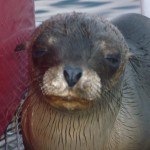 outpost and is now part of the Channel Islands National Marine Sanctuary. One area is designated a Marine Protected Area (MPA) where it is, look only and take nothing! This area is the Santa Barbara Island Marine Reserve (MR) that takes up the southwest corner of the island and includes the Rookery and South Point.
outpost and is now part of the Channel Islands National Marine Sanctuary. One area is designated a Marine Protected Area (MPA) where it is, look only and take nothing! This area is the Santa Barbara Island Marine Reserve (MR) that takes up the southwest corner of the island and includes the Rookery and South Point.
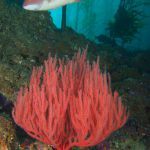 Santa Barbara Island was formed by underwater volcanic activity. It is roughly triangular in outline and emerges from the ocean as a giant, twin-peaked mesa with steep cliffs. The highest point on the island is Signal Peak that is 635 feet in elevation. The island can look quite barren at times, but changes with the seasons.
Santa Barbara Island was formed by underwater volcanic activity. It is roughly triangular in outline and emerges from the ocean as a giant, twin-peaked mesa with steep cliffs. The highest point on the island is Signal Peak that is 635 feet in elevation. The island can look quite barren at times, but changes with the seasons.
The best time is the spring when the coreopsis blooms with bright yellow flowers. After the flowers die the coreopsis goes dormant and looks as though it’s dead waiting for another springtime to turn the hills into a beautiful sight. Other plants, like the endemic Santa Barbara Island live-forever, shrubby buckwheat, chicory, and cream cups, add touches of color to the island.
For those that would like to get up close and personal with Santa Barbara Island, there are hiking trails, kayaking, snorkeling, and tent camping on the island with Island Packers running trips out to the island throughout the year when weather permits.
 The rocky shores of Santa Barbara Island are host to a large pinniped population for California sea lions, harbor seals, and northern elephant seals. They feed in the rich kelp forests surrounding the island and you can hear there barking from a distance. The island has steep cliffs around the sealion rookery where you can watch them climb up the cliffs and slide down having fun all day long.
The rocky shores of Santa Barbara Island are host to a large pinniped population for California sea lions, harbor seals, and northern elephant seals. They feed in the rich kelp forests surrounding the island and you can hear there barking from a distance. The island has steep cliffs around the sealion rookery where you can watch them climb up the cliffs and slide down having fun all day long.
If you are on the island there are overlooks, such as the Sea Lion Rookery, Webster Point, and Elephant Seal Cove, which provide excellent spots to look down on them. Santa Barbara Island may be small but it has many things to offer, both above and below the water.
Diving Santa Barbara Island
 Diving at Santa Barbara Island is always a treat and the main reason most divers like to go there is because of the seals and sea lions at the Rookery, off the island’s southeast side but there are many other excellent sites for the beginning to advance diver. The sea lions can be fun to watch spinning and twirling just like acrobats. They will also swim at you and then turn at the last possible moment as they blow bubbles at you.
Diving at Santa Barbara Island is always a treat and the main reason most divers like to go there is because of the seals and sea lions at the Rookery, off the island’s southeast side but there are many other excellent sites for the beginning to advance diver. The sea lions can be fun to watch spinning and twirling just like acrobats. They will also swim at you and then turn at the last possible moment as they blow bubbles at you.
The island is very 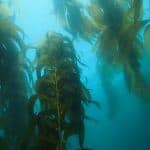 diverse with kelp forests, caves, underwater arches, pinnacles, and rocky reefs plus there is a variety of aquatic creatures such as bat rays, lobster, sea lions, large schools of fish, gorgonians, and lots of invertebrates all in large extensive kelp beds not to mention the many excellent dive sites to explore around Santa Barbara Island for any level diver whether you are on a single day or multi-day trip.
diverse with kelp forests, caves, underwater arches, pinnacles, and rocky reefs plus there is a variety of aquatic creatures such as bat rays, lobster, sea lions, large schools of fish, gorgonians, and lots of invertebrates all in large extensive kelp beds not to mention the many excellent dive sites to explore around Santa Barbara Island for any level diver whether you are on a single day or multi-day trip.
 Some of the great dive sites are Arch Reef where you will find purple hydrocoral, Sutil Pass (20’-70’ deep) next to Sutil Island which is a 300’ rock with its kelp forests and bat rays during the summer, Shag Rock (30’-70’ deep) with its rocky reefs that are great for hunters looking for halibut, fish or lobsters and Black Caverns (60’-100’ deep) which is a favorite advanced dive site for its caves and caverns with plenty of room between the floor and the ceiling.
Some of the great dive sites are Arch Reef where you will find purple hydrocoral, Sutil Pass (20’-70’ deep) next to Sutil Island which is a 300’ rock with its kelp forests and bat rays during the summer, Shag Rock (30’-70’ deep) with its rocky reefs that are great for hunters looking for halibut, fish or lobsters and Black Caverns (60’-100’ deep) which is a favorite advanced dive site for its caves and caverns with plenty of room between the floor and the ceiling.
What to Expect
These sites are 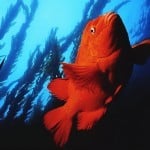 excellent for the photographer, sightseer, and spearfisherman. Calico bass, white sea bass, yellowtail, and an occasional tuna are among the types of game fish that can be found in the waters surrounding the island. As with all Channel Islands, lobster divers make this a prime destination during bug season.
excellent for the photographer, sightseer, and spearfisherman. Calico bass, white sea bass, yellowtail, and an occasional tuna are among the types of game fish that can be found in the waters surrounding the island. As with all Channel Islands, lobster divers make this a prime destination during bug season.
You can dive the island year-round weather permitting. The best time is in the late summer to fall months. Visibility here can be anywhere from 20’-60’ plus but generally, it is more in the 40-50’ range and water temperature can be between the low 50’s to mid-’60s.
Even though the island is small we will cover it into two sections: Eastside from Arch Point to South Point and the Westside from South Point to Arch Point.
Listed are a few of the great dive sites around Santa Barbara Island:
Eastside from Arch Point to South Point:
- Landing Cove-Nice anchorage with shallow rocky reef and lots of kelp. Good structure with small crevices, kelp, lobster, some fish, and a good number of invertebrates. Best for photography. Depths are between 20’-40’.
- The Rookery-Shallow rocky area with large rocks, crevices, and sandy bottom. Some areas have large depressions in the rocky reef along with some kelp growing from the larger rocks. If the seas are calm you can get in nice and close to where the sea lions are resting and playing above and a good chance of bat ray sights in the sand. Some lobsters and small fish in the area. Great spot to dive with the sea lions and watch them do their acrobatic moves. Depths are between 10’-40’.
- Drop Off Reef-Known also as Southeast Reef. This rocky reef has a shallow plateau that drops to the sand creating a large wall. Lots of kelp and large cervices along the wall with ledges. There are nice size fish here but it is in the Santa Barbara Island Marine Reserve (MR) so no hunting allowed. Can be good for wide-angle photography plus there is lots of invertebrate life here. Sea lions are common along with occasional sightings of giant black sea bass. Depths are between 30’-100’.
- Three Sisters-close to South Point and this site has 3 smaller exposed rocks hence the name “Three Sisters”. Rocky reef area with lots of healthy kelp, sheepshead, rockfish, kelp bass, bat rays, sea lions, and more. It is shallow around the three rocks and gets deeper to the sandy bottom as you head out away from the island creating some small walls and large crevices. Depths are between 15’-60’.
Westside from South Point to Arch Point:
- Sutil Island-Very rocky area all along the island sloping down to deeper depths. Some walls and lots of crevices with lots of kelp, calico, sheepshead, rockfish, sea lions, and more along with much invertebrate life on the rocks. Large sea stars, possible bat rays, and giant black sea bass. Both hunting and photography can be good here. Depths are between 25’-80’.
- Outer Reefs-Santa Barbara Island has many excellent offshore reefs when weather and currents are in your favor. Most all the boats visiting the area have some great spots to put divers on. All of these are very rocky, with large crevices and ledges, and can be excellent for the hunter or photographer. Some of these areas will also have purple hydro coral, lobsters, good size fish, and healthy kelp. Most of these are deeper with depths between 60’-130’ but an average of about 80’-111’ is not uncommon.
- Shag Rock-Large exposed rock with jagged rocky reef all around it. Steep sides creating walls and big crevices home to lobster, sheepshead, lingcod, rockfish, kelp bass, gorgonians, and lots of kelp. Depths are between 30’-80’.
- Arch Rock-This is sometimes called Hidden Reef and is offshore to the west of Webster Point. It is a large rock that comes almost to the surface with kelp on it and at about 50’ it has a big arch that you can swim through. Steep sides with rocky reef and lots of large crevices all around it with large sea stars, sheepshead, lobsters, rockfish, and kelp bass making it a good spot for hunters. Because current can be an issue there is much invertebrate life here and a great spot for photographers. Depths are between 20’-80’.
- Black Cavern-There are a number of underwater caverns around Santa Barbara Islands but this one is supposedly the largest. It is offshore from Webster Point and is an advanced dive with the opening at around 90’-100’. The reef is rocky with lots of crevices and ledges and home to sheepshead, lobsters, rockfish, and kelp bass making it a good spot for hunters. There is also much invertebrate life here and a great spot for photographers. Depths are between 60’-120’.
San Nicolas Island
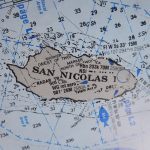 San Nicolas Island is the most northwesterly of the four southern Channel Islands. San Nicolas is one of the smallest of the eight Channel Islands, larger only than Santa Barbara and Anacapa Islands. Like its eastern neighbor San Clemente Island, San Nicolas is a US Navy-owned and operated island. Located 65 nautical miles southwest of the Point Mugu complex in Ventura County, San Nicolas Island is the cornerstone in the Sea Range
San Nicolas Island is the most northwesterly of the four southern Channel Islands. San Nicolas is one of the smallest of the eight Channel Islands, larger only than Santa Barbara and Anacapa Islands. Like its eastern neighbor San Clemente Island, San Nicolas is a US Navy-owned and operated island. Located 65 nautical miles southwest of the Point Mugu complex in Ventura County, San Nicolas Island is the cornerstone in the Sea Range 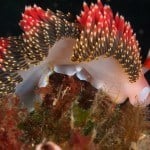 capabilities.
capabilities.
The waters surrounding the island are split into three zones that are controlled by the Navy. Because of its location, isolated environment, and shoreline characteristics, San Nicolas Island is ideal for conducting test and training exercises along with providing littoral warfare training, including tri-service and theater warfare exercises.
It is also an excellent environment for 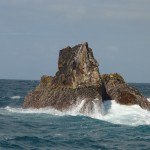 conducting classified operations. Although the island is officially uninhabited as of the 2000 U.S. Census, it is estimated that the number of military and civilian personnel on the island numbers at least 200 at any given time. The island has a small airport, several buildings, support services, and telemetry reception antennas.
conducting classified operations. Although the island is officially uninhabited as of the 2000 U.S. Census, it is estimated that the number of military and civilian personnel on the island numbers at least 200 at any given time. The island has a small airport, several buildings, support services, and telemetry reception antennas.
Diving San Nicolas Island
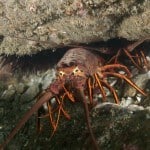 Scuba diving at San Nicolas Island is more for the advanced diver looking for an adventure hunting the legendary “Bull lobsters of San Nick”. Because of its hostile and productive dive environment, it has become legendary among California divers. The weather and remoteness of San Nicolas make it much harder to get to than the other islands plus at any given time testing and training, exercises might create area closures at the last minute making a trip to San Nicholas a 50/50 proposition.
Scuba diving at San Nicolas Island is more for the advanced diver looking for an adventure hunting the legendary “Bull lobsters of San Nick”. Because of its hostile and productive dive environment, it has become legendary among California divers. The weather and remoteness of San Nicolas make it much harder to get to than the other islands plus at any given time testing and training, exercises might create area closures at the last minute making a trip to San Nicholas a 50/50 proposition.
The diving is usually done on the north and west sides of the island 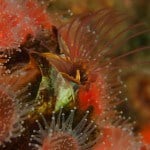 while the eastern side is generally off-limits. San Nicolas has thick forests of giant kelp around the entire island, attracting marine mammals, fish and invertebrates. A diverse mixture of northern cold-water and southern warm-water fish intermingle in the island waters. Sea fans, sea stars, anemones, invertebrates, sea lions, harbor seals, elephant seals, and lobsters are found at San Nicolas Island.
while the eastern side is generally off-limits. San Nicolas has thick forests of giant kelp around the entire island, attracting marine mammals, fish and invertebrates. A diverse mixture of northern cold-water and southern warm-water fish intermingle in the island waters. Sea fans, sea stars, anemones, invertebrates, sea lions, harbor seals, elephant seals, and lobsters are found at San Nicolas Island.
Listed are a few of the great dive sites around San Nicholas Island:
- Begg Rock- Large pinnacle/ seamount that sticks out of the water about 15’ and is located eight miles northwest of San Nicolas Island. It is exposed to weather from all directions and on CALM days can be an excellent dive. Now a Marine Reserve (MR) it rises 300 feet from the ocean floor to the surface and is carpeted with invertebrate life, big fish scallops, and more. Excellent for photography. Depths are between 40’-130’ plus.
- The Boilers-Very rocky area with lots of submerged rocks and boulders that creates the water to appear to boil from the surge and swell that frequent this area, hence it can only be dived on the calmest of days. Excellent for spearfishing rockfish, lingcod, and sheepshead, and good hunting for lobsters. Also, plenty of invertebrate life here along with large anemones and gorgonians. Depths are between 35’-80’.
- Alpha area-Diving this area can be quite good for spearfishing and lobster hunting but only on days when the Navy allows entry into the Alpha area. The reef here is rock piles with sand between them having lots of holes and crevice for lobster to hide. Best here for lobster hunting but like all areas around San Nicholas Island there is plenty of small invertebrates on the rocks to give the photographer something to do. Depths are between 30’-60.
- Dutch Harbor-Excellent shallow reef system here and it is the only protected anchorage at San Nicholas Island. Lots of large rocks and structures to explore with crevices and ledges. Plenty of kelp here along with lots of invertebrate life and some fish. Not the best for spearfishing or hunting but great for macro photography. Depths are between 25’-50’.
- Three Mile Reef-Located far offshore and only diveable on calm days but when it is the diving here can be superb. Excellent pinnacle/ rocky reef with lots of structure and crevices to explore. Excellent for spearfishing rockfish, lingcod, and sheepshead and good hunting for lobsters. Because it is so exposed it is also great for photographers to find plenty of invertebrate life to keep you busy for more than one dive. Depths are between 60’-120’.
- Outer Reefs and Pinnacles- There are plenty of other excellent offshore pinnacles around San Nick just like Three Mile Reef waiting to be dived on calm days. Excellent pinnacle/ rocky reef with lots of structure and crevices to explore. All can be excellent for spearfishing rockfish, lingcod, and sheepshead and good hunting for lobsters. Because these sites are so exposed they can also be great for photography finding plenty of invertebrate life to keep you busy for more than one dive. Depths are between 40’-120’.